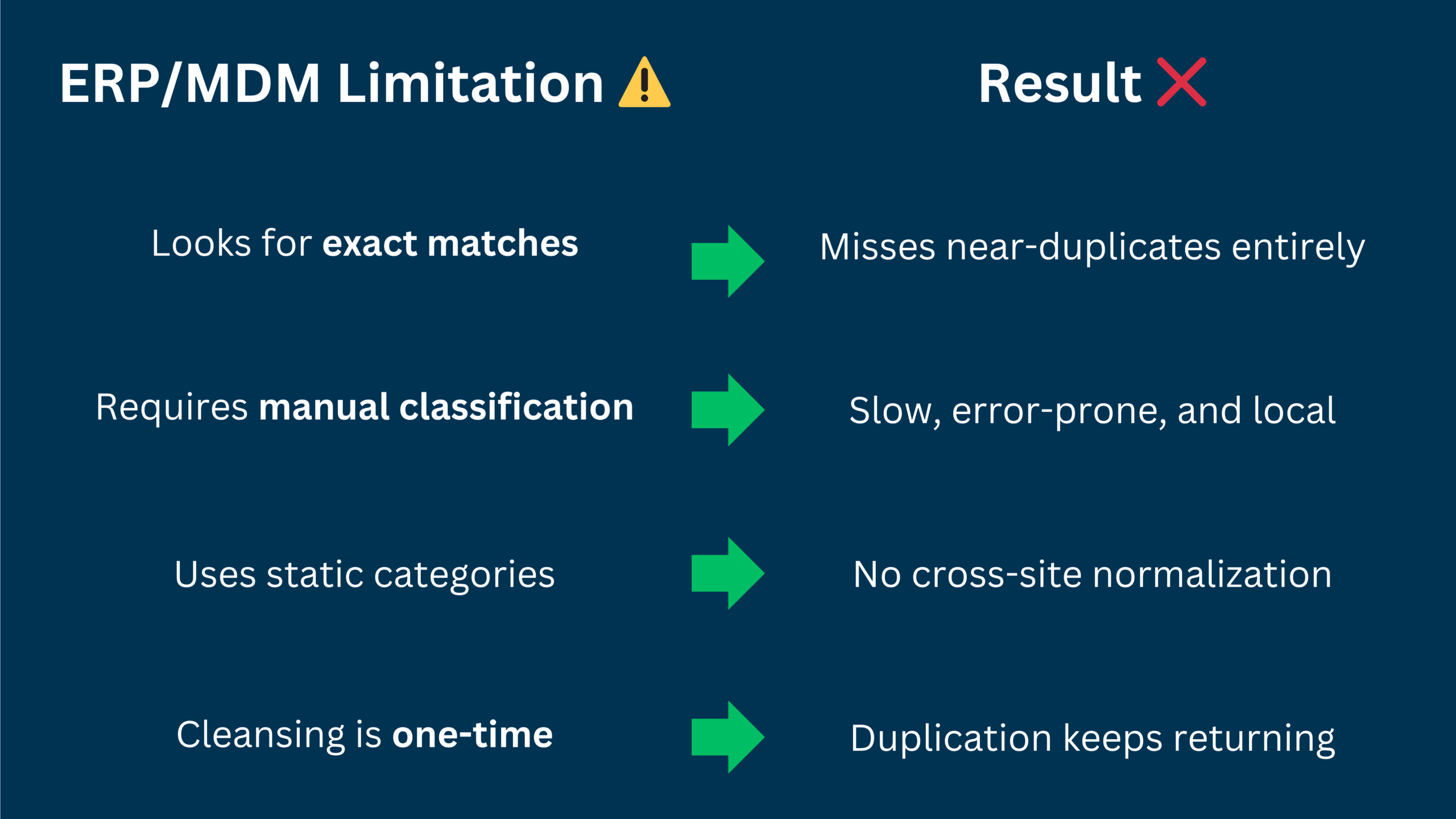How AI Eliminates Duplicate MRO Materials – and Why Your ERP Can’t
Same Part, Five SKUs. You’re Not Wasting Time – You’re Wasting Millions.

At first glance, it looks harmless.
“Ball Bearing – 6205-ZZ”
“6205ZZ Bearing 25mm”
“6205-2RS C3 – SKF”
Three records. Three SKUs.
Each from a different supplier. Each is stocked at different sites.
All referring to the same part, just described, classified, and ordered differently.
Now multiply that by 50,000+ SKUs, across 20+ plants.
That’s not a naming problem. That’s a working capital crisis in disguise.
Why This Guide?
This isn’t just another “clean your data” pitch.
You’re about to learn:
- Why duplicate MRO materials are a systemic issue, not a clerical one
- How AI finds what ERP and MDM systems can’t
- What real results look like at enterprise scale
- What to avoid if you’re being told to “just standardize your taxonomy”
Why Duplicate MRO Parts Exist (Even in “Optimized” Systems)
Let’s get real:
ERP wasn’t built for MRO complexity.
You’re dealing with:
- Multiple sites ordering independently
- Different naming conventions, vendor part numbers, and units of measure
- Legacy data from past system migrations
- No clear ownership over part records
Even world-class maintenance and sourcing teams run into this.
It’s not a people problem. It’s a visibility problem.
Why ERP and MDM Tools Can’t Catch It
Here’s why your ERP says everything’s fine:

You don’t need another batch cleanse.
You need continuous, contextual data unification, which is exactly what AI can do.
How AI Actually Detects and Unifies MRO Duplicates
Verusen’s platform uses machine learning, natural language processing (NLP), and probabilistic modeling to detect duplicates without rewriting your data.
Here’s how:
1. Cross-Site Data Ingestion
Pulls material records across multiple ERPs, CMMS platforms, and Excel files. No reformatting needed.
2. Pattern & Contextual Matching
Understands that “6205-ZZ SKF” and “Ball Bearing 25mm” may describe the same part, based on:
- Description structure
- Category probability
- Manufacturer/vendor ID
- Past usage and order behavior
3. Confidence-Based Matching
Each pair/group of potential duplicates is scored (e.g., 92% match, 86%, etc.)
You define the threshold for flagging or linking – no risky auto-merging.
4. Virtual Unification (Not Destructive Cleansing)
Verusen builds a unified view at the platform level, so you gain insight without touching ERP records or triggering reordering rules.

Real Results: $10M in Duplicates Resolved
Company: North America’s Largest Downstream Oil Refining Co.
Problem: Fragmented MRO data across sites, inefficiencies in managing categories and suppliers, disconnected workflows and siloed collaboration led to excess inventory & duplicates.
Action: Unified platform for visibility and collaboration, optimized inventory, streamlined workflows for better collaboration.
Results:
- $10 million saved through Duplicate Materials Consolidation.
- $81 million in total identified savings opportunities over four years.
- Enhanced stocking policies and increased visibility to prevent stockouts and duplicates.
Why This Matters to Ops, Procurement, and Finance
For the VP of Operations:
- Get fewer stockouts and more consistent uptime
- Stop buying the same part from 3 different suppliers
For Procurement Leaders:
- Consolidate suppliers with confidence
- Negotiate better – backed by accurate usage data
For Finance:
- Reduce MRO carrying costs without disrupting critical assets
- Actually trust the inventory value on the balance sheet
What Not to Do
- Don’t kick off another 6-month manual cleanse project
- Don’t push for ERP migration just to “get clean.”
- Don’t accept that “some duplication is normal” – it’s not when you can see it
FAQs
Can AI really detect duplicates across different languages/systems?
Yes – NLP and historical ordering behavior help identify matches even with different naming conventions.
Will it change our ERP data?
No. Verusen overlays existing systems. It unifies visibility, not master records (unless you choose to sync).
How accurate is it?
Most organizations use 85–95% match thresholds. You control approvals and merging logic.
Want to Know How Many Duplicates Are Hiding in Your Inventory?
We’ll run a diagnostic on your MRO data and show you your top 50 highest-risk duplicates in just days.→ Book a Duplicate Detection Session

